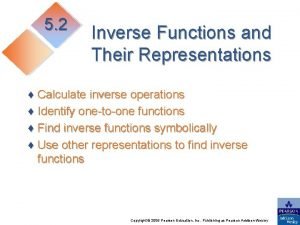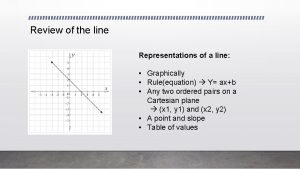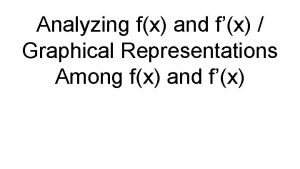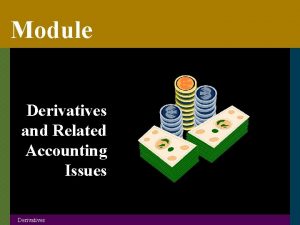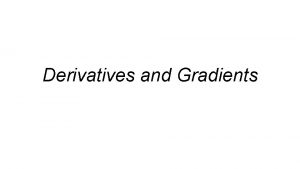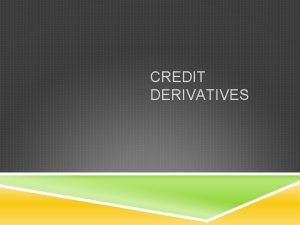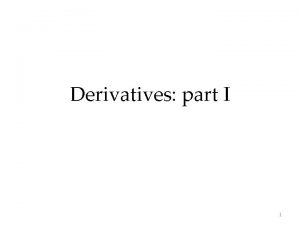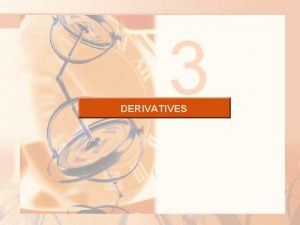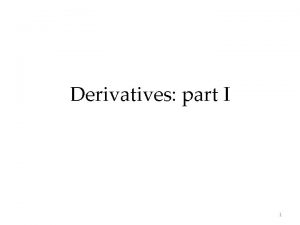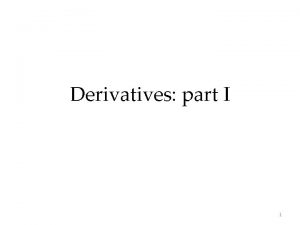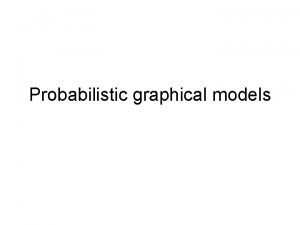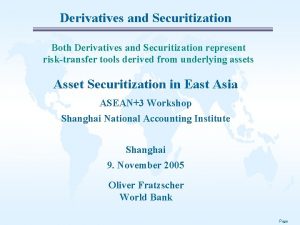Analyzing f and Derivatives Graphical Representations among f














- Slides: 14

Analyzing f and Derivatives/ Graphical Representations among f and Derivatives William & Ali

Classwork and Homework To Do: Classwork: Homework: Analyzing f and derivatives All even MC, 1, 3, 5, 15 7 -13 odd, 14, 16, 17 Graphical representations among f and derivatives All even MC, 1, 5 3, 7, 9, 13, 14, 15, 16, 17

Review: Derivatives & Critical Points ● ● ● A derivative is the instantaneous rate of change (also known as the slope of the tangent line) of f(x) at a certain point Critical points on a graph occur when the derivative is equal to zero or does not exist Critical points can tell us when f(x) is changing from increasing / decreasing or changing concavity

Review: Relation between f(x) and f’(x)

Review: Increasing/ Decreasing & Concavity ● ● f(x) is concave up when f’’(x) is greater than zero. f(x) is concave down when f’’(x) is less than zero. When f(x) is concave up, the tangent line is below the curve. When f(x) is concave down, the tangent line is above the curve.

Review: Points of Inflection ● ● ● Points of inflection occur when f(x) changes concavity Inflection points are determined by the second derivative If f’’(x) changes signs, then there is a point of inflection.

12: Finding and Classifying Relative Extrema Steps for Finding Relative Extrema 1. 2. 3. 4. Find the derivative of the function or f’(x) Set the derivative equal to zero Use factoring to find the x-values where the function is undefined or equal to 0. Use sign charts to determine if a critical number is a relative minimum, maximum, or neither. Relative Extrema Justifications: Relative Minimum - f(x) has a relative minimum at x = a because f’(x) switches from a negative to a positive sign when x = a. Relative Maximum - f(x) has a relative maximum at x = a because f’(x) switches from a positive to a negative sign at x = a.

13: Finding Absolute Extrema on a Closed Interval ● Absolute Extreme: The maximum or minimum value on a given domain. *Do not forget to check the endpoints ● ● Steps to find it: ○ Set the derivative equal to zero to find critical points ○ Make a chart of critical points and endpoints ○ Find the Y - values ○ The largest Y - value is the max and the smallest one is the minimum Justification: “F(x) has an absolute max on the interval (a, b) because F’(x) changes from positive to negative when x=a and F(a) is less than F(x) at the endpoints”

14: Intervals of Increasing / Decreasing Increasing: where f’(x) is positive or > 0 Decreasing: Where f’(x) is negative or < 0 Justifications: f(x) is increasing on the interval (a, b) because f’(x) > 0 f(x) is decreasing on the interval (a, b) because f’(x) < 0

15: Determining Concavity and Points of Inflection ● ● ● Concavity refers to the shape of F(x) To determine concavity, we need to find F’’(x) ○ If the second derivative is positive then F(x) is concave up ○ If the second derivative is negative, then F(x) is concave down ○ Justification: “F(x) is concave up on the interval (a, b) because F’’(x) is positive” Point of inflection is when concavity changes (Meaning F’’(x) changes signs) ○ Justification: “F(x) has a POI at x = a because F’’(x) changes signs when x = a)

16: Second Derivative Test The Second Derivative Test is also used to determine relative extrema. Critical Numbers: x-values that make f’(x) zero or undefined 1. 2. 3. Plug in the critical numbers from the first derivative into the second derivative. If f’’(x) is positive, then the critical point is a relative minimum If f’’(x) is negative, then the critical point is a relative maximum

17: Justifications Tips for justifications: ● ● ● Justifications must be written in sentence form Sign charts are useful to determine changes in charge, but never use it as justification. Always include the interval the conditions apply to. Be specific (Do not use the word “it” unless “it” is defined) Make it clear which derivative is being used for the test

kahoot ! https: //create. kahoot. it/details/analyzing-f-and-derivatives-graphical-representations-among-f-andderivatives/ceccb 37 f-7168 -479 c-8710 -9591 faa 0 f 986 Created by: Ali

5 n 1 Created by: William
 Representations of pompeii and herculaneum over time
Representations of pompeii and herculaneum over time Cultural representations and signifying practices
Cultural representations and signifying practices Floor plan maths literacy grade 12
Floor plan maths literacy grade 12 Map work mathematical literacy pdf
Map work mathematical literacy pdf Maps, plans and other representations of the physical world
Maps, plans and other representations of the physical world Strip map mathematical literacy
Strip map mathematical literacy Functions and their representations
Functions and their representations On single image scale-up using sparse-representations
On single image scale-up using sparse-representations Generalization and example pattern organizer example
Generalization and example pattern organizer example Examples of non linguistic representation
Examples of non linguistic representation Unit 1: media representations mark scheme
Unit 1: media representations mark scheme Representations of a line
Representations of a line Efficient estimation of word representations invector space
Efficient estimation of word representations invector space Distributed representations of words
Distributed representations of words Isa 580 written representations summary
Isa 580 written representations summary






